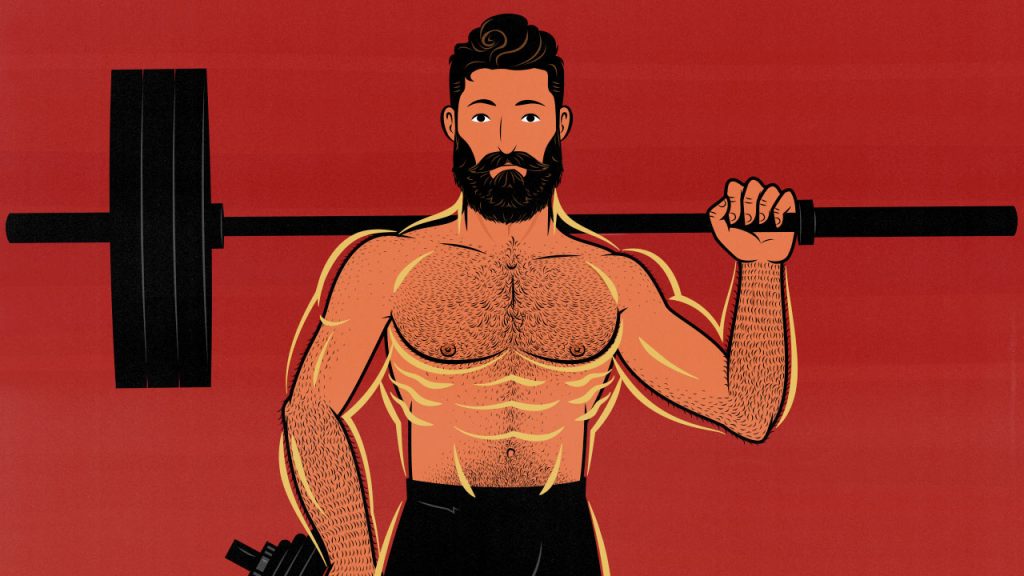
The Best 5-Day Workout Splits for Building Muscle
5-day workout splits can be incredibly good for building muscle if you program them properly. When you’re training this often, it’s easy to beat up your hands, tire out your back, or accumulate nagging aches. Fortunately, there are simple methods for avoiding all those problems, which we’ll delve into in a moment.
My two favourite 5-day workout splits are the Bro Split and the Outlift Split. Both are similarly good for building muscle, but I have a soft spot for the Outlift split. We’ll break down both splits in detail.
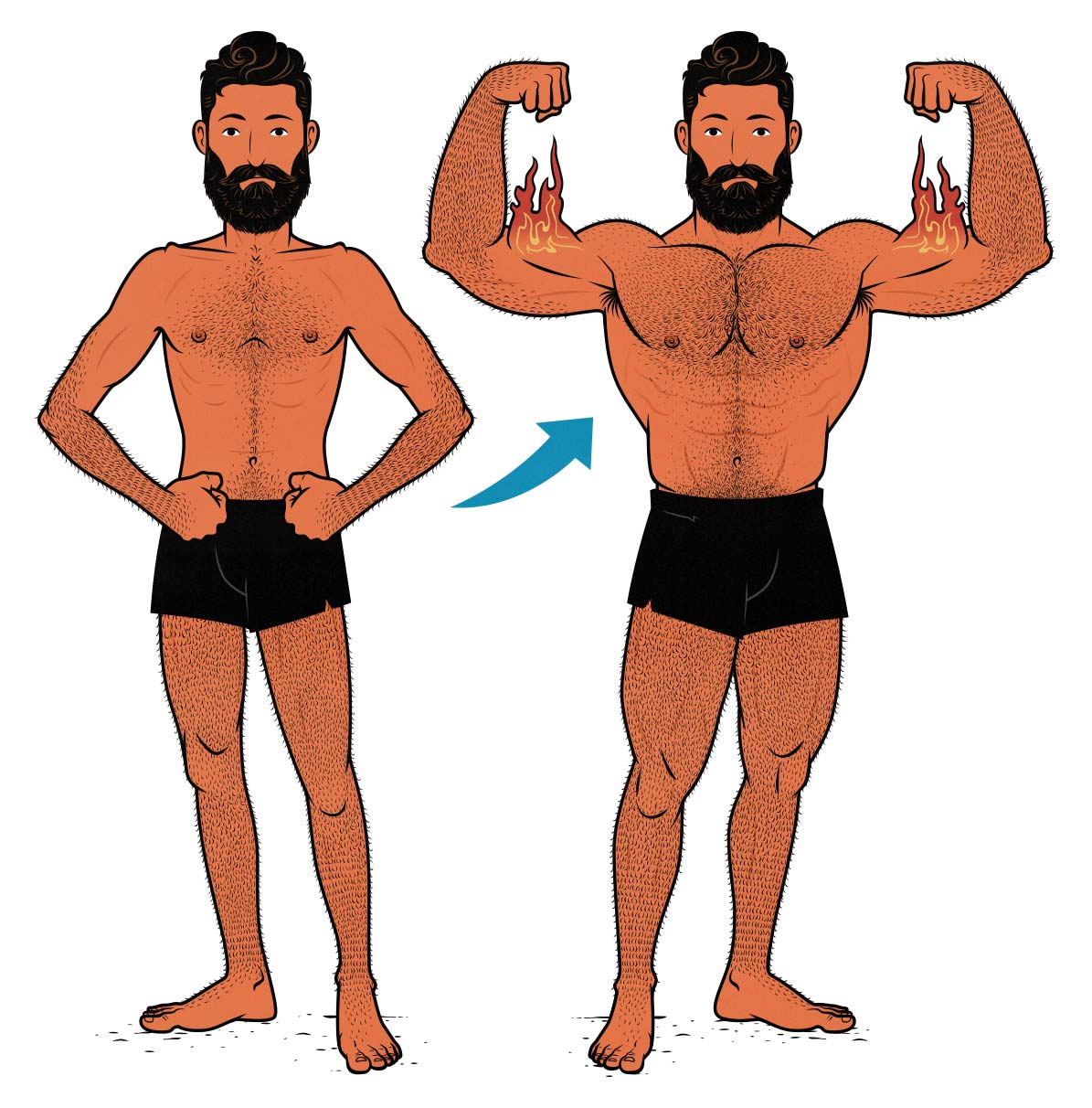
What Are 5-Day Workout Splits?
5-day workout splits are workout routines that have you doing 5 different workouts per week. The most common is the Bro Split, where each day focuses on a different body part, like so:
- Monday: Chest Day
- Tuesday: Back Day
- Wednesday: Shoulder Day
- Thursday: Leg Day
- Friday: Arm Day
- Saturday: Rest
- Sunday: Rest
The underlying idea is that rigorously training a muscle stimulates 2–3 days of growth. If you train a muscle every day, you won’t be fully recovered, hindering your performance. If you wait longer than 3–4 days before training a muscle again, that muscle will be waiting with you, not growing.
You can train your muscles more often if you train them less vigorously. This is called high-frequency training. You can find 5-day splits that train every muscle every workout. That’s rare. It doesn’t seem to yield any extra muscle growth, and overuse injuries become more common.
All the classic 5-day workout splits have a way of dividing up the body into different areas. There are tons of variations. You could alternate between training your upper body and lower body. You could cycle between pushing, pulling, and leg exercises. You could even combine both, like so:
- Monday: Upper Body
- Tuesday: Lower Body
- Wednesday: Rest
- Thursday: Push Day
- Friday: Pull Day
- Saturday: Leg Day
- Sunday: Rest
My favourite 5-day split is a variation on the Upper/Lower Workout Split. More on that in a moment.
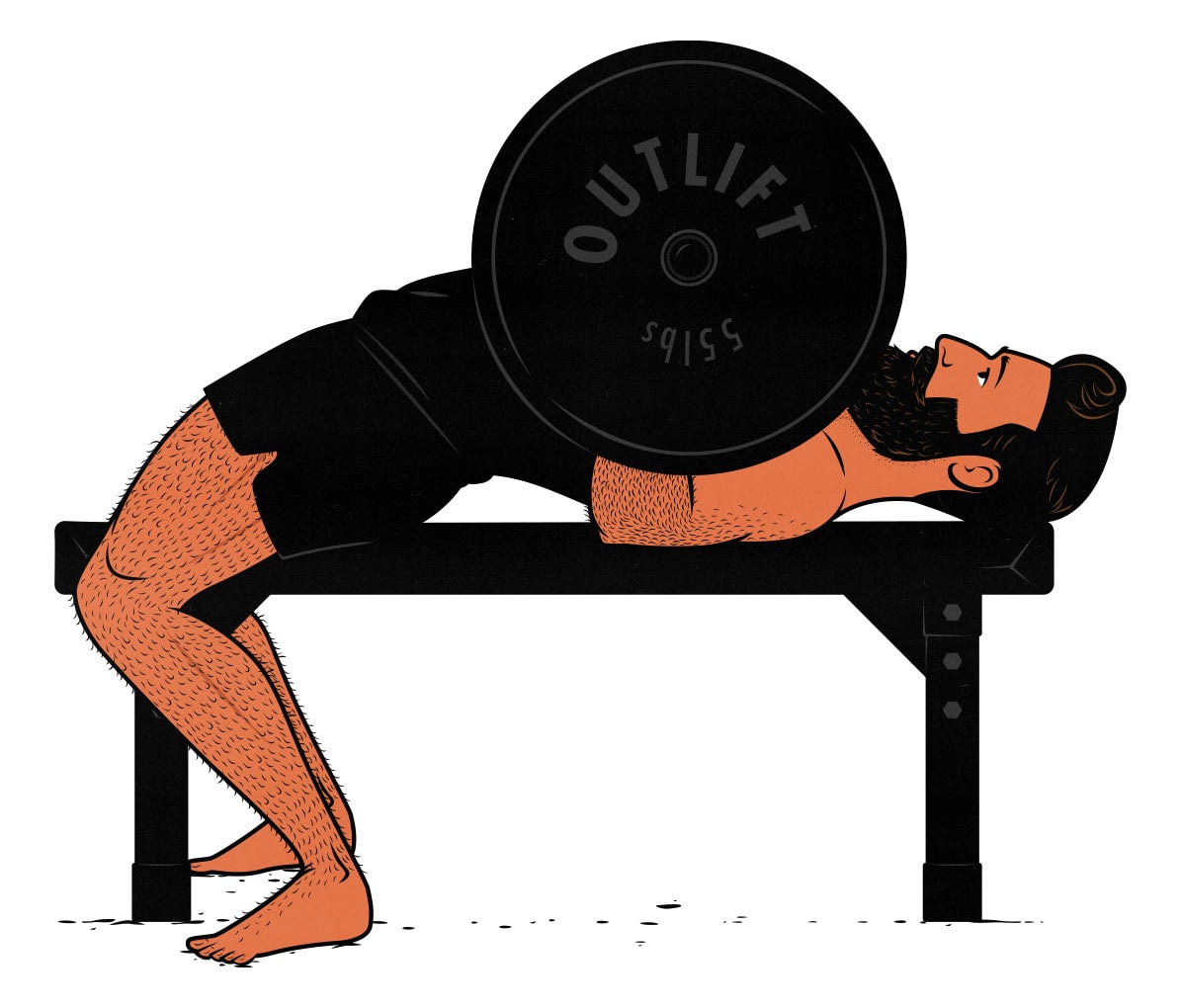
Are 5-Day Workout Splits Effective?
5-day workout splits are great for building muscle. They aren’t necessarily better than 3-day, 4-day, or 6-day routines, though. It all depends on what exercises you choose, how well you train, how much effort you put in, and how you divide up your training volume.
Dividing your training volume into 3 full-body workouts is a great default for beginners. I gained my first 50 pounds that way. But as you get stronger, full-body workouts become more fatiguing, eventually devolving into neverending nightmare slogs.
Splitting your work over 5 training days makes the workouts easier, and it also gives you time to do more exercises—especially more isolation exercises. That allows you to focus on more muscles at any given time.
So, there are two ways to program a 5-day split:
- You could do short workouts. 2–3 exercises 5 days per week. A few sets of dips, a few sets of pull-ups, some biceps curls, and you’re out in 20 minutes. I do this during periods of maintenance. I really enjoy it.
- You could take a maximalist approach to building muscle. You could use your generous training schedule to pack more volume into your workout routine, stimulating even more muscle growth. This can work great while bulking.
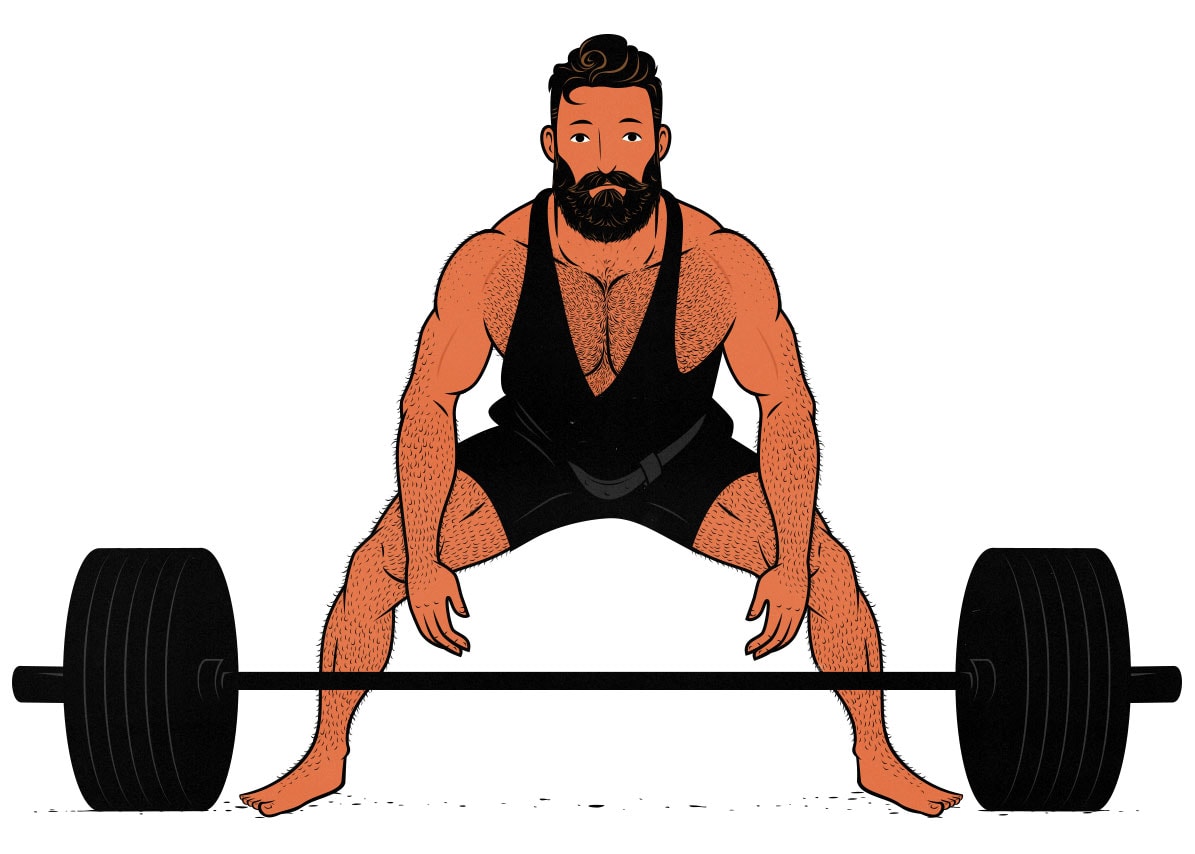
The 5-Day Bro Split
How the Bro Split Works
The 5-Day Bro Split is a traditional bodybuilding routine. It’s the most common workout split among serious bodybuilders, and with good reason: they’re great for building muscle.
- Monday: Chest Day
- Tuesday: Back Day
- Wednesday: Shoulder Day
- Thursday: Leg Day
- Friday: Arm Day
- Saturday: Rest
- Sunday: Rest
Bro Splits are body-part splits, meaning every day focuses on a different body part. At first, that might sound like each day focuses on a different muscle group, but that’s not quite right. Arms aren’t a muscle group. Neither are shoulders. And that’s a good thing.
The magic of a Bro Split is how these days overlap with one another. You can train your front delts on Chest Day and Shoulder Day. You can train your biceps on Back Day and Arm Day. This lets you train your muscles 2–3 times per week, ensuring they grow all week long.
However, Bro Splits aren’t very good for beginners. They aren’t great for building bigger legs. And lifting weights 5 days per week doesn’t leave much time for cardio.
The Bro Split Workout Routine
We’ve got a full 5-day Bro Split workout routine in our Bro Split article. Everything is fully explained there. It’s a good routine. I think you’ll like it.
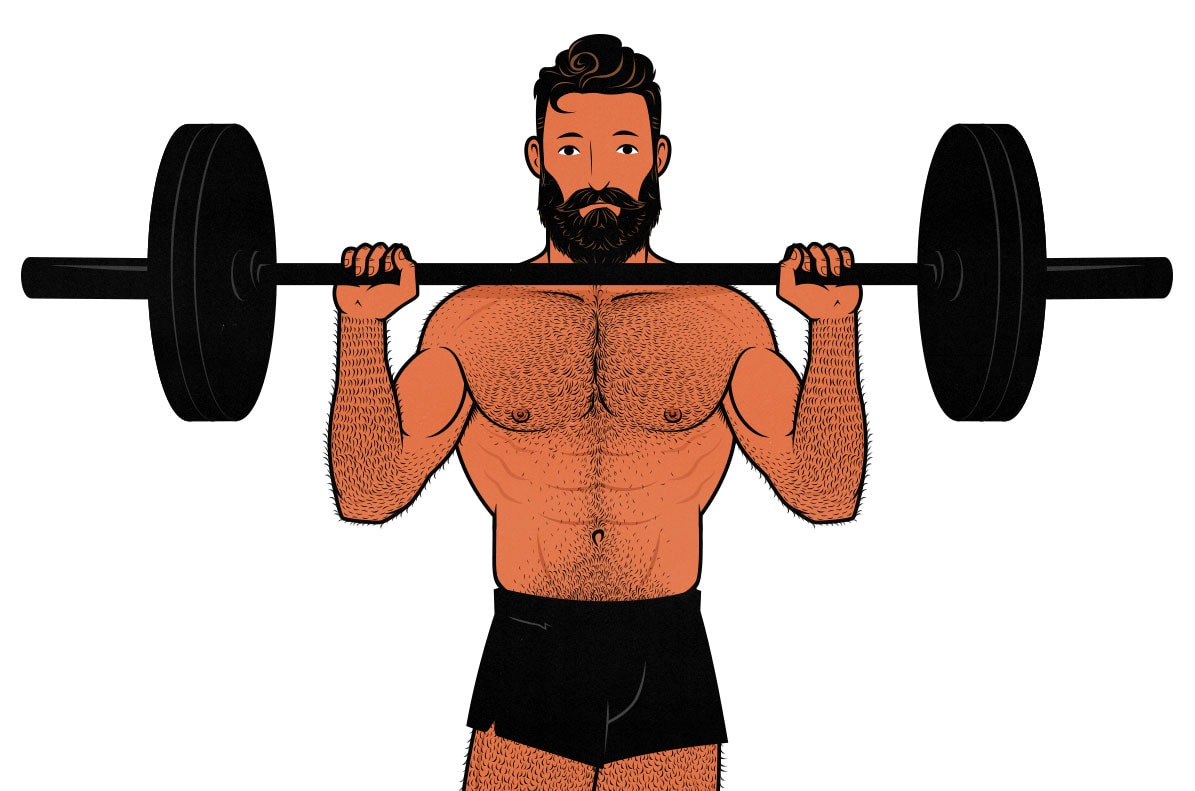
The 5-Day Outlift Split
This is the 5-day split we use in our Intermediate Hypertrophy Program. It’s an upper/lower/upper/lower/upper split, giving it somewhat of an upper-body emphasis. It’s perfect for gaining muscle size and strength. It’s one of my favourite ways to train.
How the Outlift Split Works
Instead of splitting up the workouts into body parts, each workout is built around one of the big compound exercises, alternating between upper-body and lower-body lifts:
- Monday: Upper (Bench Emphasis)
- Tuesday: Lower (Deadlift Emphasis)
- Wednesday: Rest
- Thursday: Upper (Overhead Press Emphasis)
- Friday: Lower (Squat Emphasis)
- Saturday: Upper (Chin-Up Emphasis)
- Sunday: Rest
These compound exercises aren’t set in stone, but you should keep the movement pattern the same. For example, you could swap the bench press for weighted dips. (Our program lets you pick your exercise variations from dropdown menus.)
This program puts a huge emphasis on progressive overload. On bench day, your goal is to bench more weight or get more reps than last time. That’s the main driver of muscle growth. That’s what will guarantee your progress.
After the main lift, you move to smaller exercises for your upper body. So after the bench press, you might do rows, skullcrushers, and pulldowns. This allows you to train your upper body 3 times per week and your lower body twice. It also gives you the option of supersetting your exercises together.
In my experience, this is the most reliable way to build muscle as an intermediate natural lifter. I’ve written more about our method here.
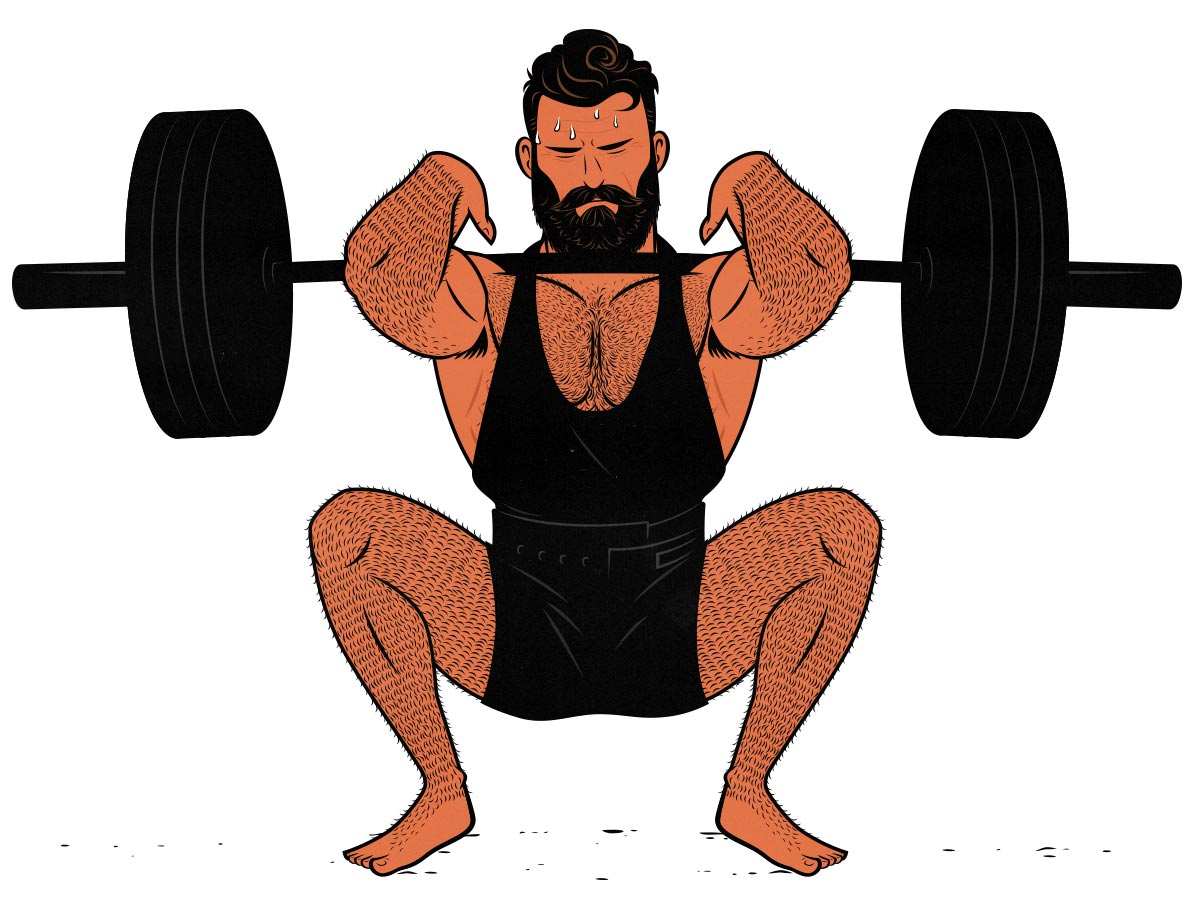
Day 1: Bench Day
| Exercise | Sets | Reps |
|---|---|---|
| Bench Press | 4–5 sets | 6-12 reps |
| Dumbbell Rows | 3–5 sets | 8-12 reps |
| Skull Crushers | 3 sets | 10-15 reps |
| Pullovers | 3 sets | 12–15 reps |
Bench Day is built around the bench press or whatever big chest exercise you prefer. I like to use the dumbbell bench press, barbell bench press, or weighted dip. The chest press machine is another good choice.
You can superset the bench press with rows. I recommend bringing a heavy dumbbell over to the bench and doing 1-arm rows, but you can use any row variation that doesn’t tire out your spinal erectors. The t-bar row machine is another great choice.
Skull crushers are an important part of building a bigger bench press. That’s why they’re here. They also ensure balanced growth in your triceps. When you finish them, you can use the same setup for doing pullovers.
If this workout feels too easy, you’re free to add an extra exercise. In our program, we let you toggle between easy/hard. The easy version has fewer exercises and sets. The hard version has more.
Day 2: Deadlift Day
| Exercise | Sets | Reps |
|---|---|---|
| Deadlift | 3 sets | 6-8 reps |
| Crunches | 3 sets | AMRAP |
| High-Bar Squat | 3 sets | 8-12 reps |
| Neck Curls | 3 sets | 12–15 reps |
Deadlift Day is built around the deadlift. I’ve always done sumo, Romanian, or conventional deadlifts here. Trap-bar deadlifts are great as well.
The squat is a good assistance exercise for the deadlift, but it’s mainly here to support your front squat. I like low-bar or high-bar squats here because they’re hard on your quads without being as demanding on your spinal erectors (which are probably tired by now).
Crunches and neck curls are discretionary exercises that superset well with the bigger exercises. You could just as easily choose calf raises and leg curls.
Day 3: Press Day
| Exercise | Sets | Reps |
|---|---|---|
| Overhead Press | 4–5 sets | 6-12 reps |
| Pull-Ups | 3–5 sets | AMRAP |
| Dips | 3 sets | AMRAP |
| Dumbbell Curls | 3 sets | 10-15 reps |
| Forearm Curls | 3 sets | 12–15 reps |
Press Day is built around an overhead press variation. I like the standing barbell “military” press. The push press is another great option. If you’re especially eager to build a big bench press, you could even do a close-grip bench press here.
If you’re doing your pressing in a power cage, you’ll have a pull-up bar handy. Pull-ups superset well with presses. Dips and dumbbell curls can be supersetted together, too. Forearm curls are a discretionary lift you can replace.
This combination of presses, pull-ups, and dips is my favourite combo for building a bigger shoulder girdle. I love this workout day.
Day 4: Squat Day
| Exercise | Sets | Reps |
|---|---|---|
| Front Squat | 4–5 sets | 6-12 reps |
| Hanging Leg Raises | 3–4 sets | AMRAP |
| Romanian Deadlift | 2–3 sets | 8-15 reps |
| Neck Curls | 3 sets | 12–15 reps |
Squat Day is built around the squat. I like the front squat here because it challenges our quads, glutes, and spinal erectors, making it a great assistance exercise for the deadlift. You could also choose a high-bar squat or leg press. If you’re squatting in a squat rack, you’ll have a pull-up bar handy, allowing you to superset leg raises.
The Romanian deadlift is next. It’s a great assistance exercise for the deadlift, and it’s great for bulking up your hamstrings and back. I like using a higher rep range here. I superset them with neck curls, but you can superset them with any small isolation exercise.
Day 5: Chin-Up Day
| Exercise | Sets | Reps |
|---|---|---|
| Weighted Chin-Ups | 4–5 sets | 5–8 reps |
| Push-Ups | 3–5 sets | AMRAP |
| Barbell Curls | 3 sets | 10-15 reps |
| Overhead Extensions | 3 sets | 10-15 reps |
| Lateral Raises | 3 sets | 12–15 reps |
Chin-Up Day is built around the weighted chin-up. Underhand, neutral-grip, and gymnastic-ring chin-ups do a better job of bringing your arms into the exercise, allowing you to go heavier. You can superset them with push-ups. You can raise your feet to make the push-ups more challenging.
Barbell curls and overhead extensions are next, supersetted together. I use an angled curl bar for both, using the same load for both exercises, bringing all sets to the cusp of failure. You can add lateral raises to the superset, turning it into a giant set.
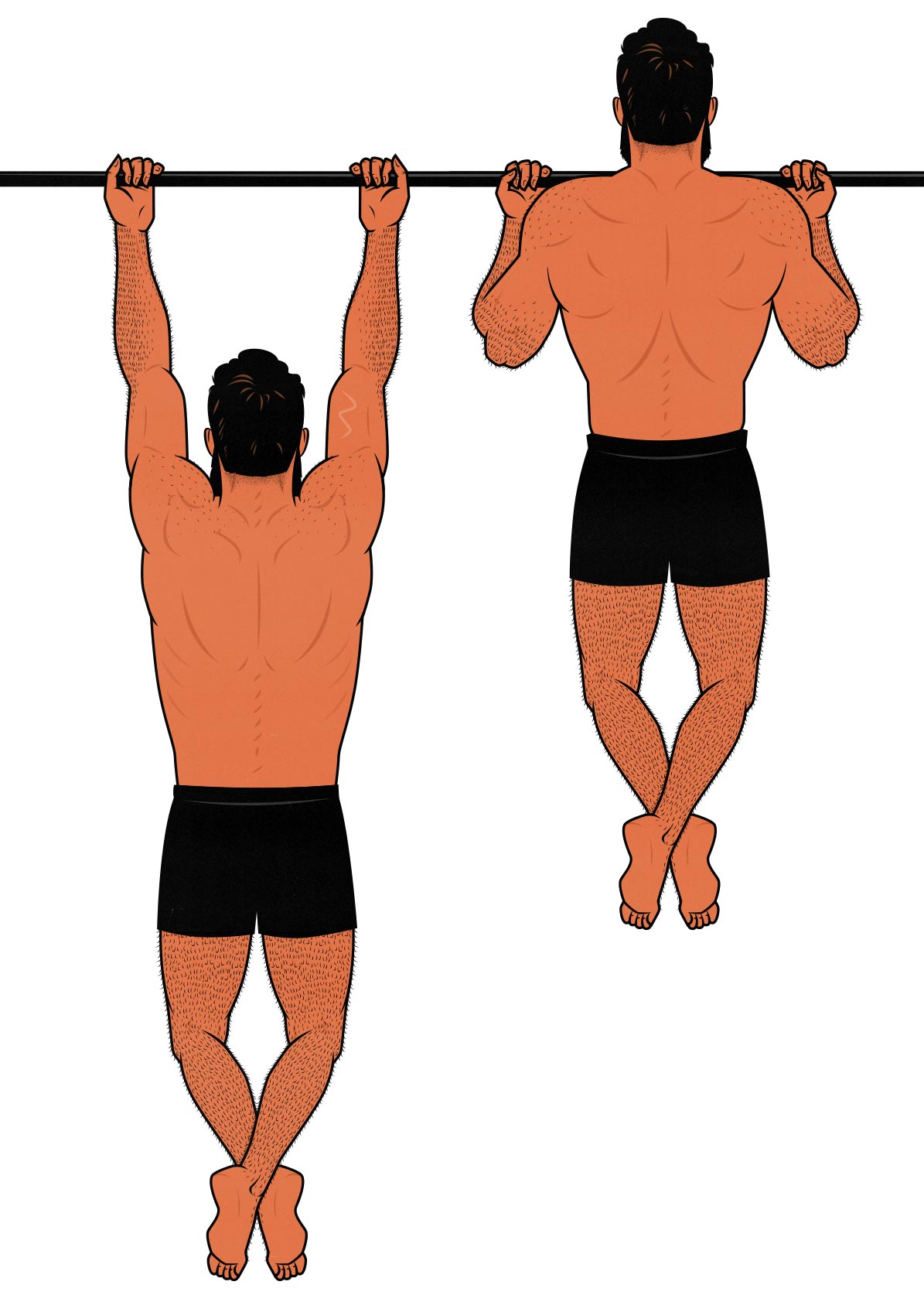
How to Do the Workout Routine
The 5-Day Outlift split focuses on progressive overload. Try your best to outlift yourself every workout, especially on the first exercise.
- Exercise selection: Choose exercises that suit your body and your goals. If you prefer dips to bench presses, choose dips. If you prefer leg presses to front squats, choose leg presses. If you prefer t-bar rows to chin-ups, choose t-bar rows.
- Volume: We have 4–5 exercises in each workout by default. In our experience testing these routines on ourselves and clients, this tends to be the best starting point.
- Progression: The goal is to gradually get stronger at the first exercise of each workout. If you hit your rep target last workout, add a little weight. If you’re still trying to add more reps, try to get more total reps than last time. For example, if you got 12, 10, 9, and 8 reps (39 reps) last workout, try to get 40+ reps this workout.
- Rest times: If you’re supersetting the exercises, rest for 1–2 minutes between sets. If you aren’t supersetting, rest for 2–4 minutes between sets. Use shorter rest times for smaller exercises and longer rest times for bigger exercises.
- Reps in Reserve: Leave 0–2 reps in reserve on most exercises, taking it easier in earlier sets and pushing closer to failure in the final sets.
- Schedule: We recommend scheduling your rest days after Deadlift Day and Chin-Up Day. That way, your back muscles have more time to recover before you train them again. But back muscles are surprisingly tough. If you do workouts Monday through Friday, you’ll be okay.
- Muscle-Building Diet: You need enough food to fuel muscle growth. If you’re skinny-fat or overweight, you can get extra energy from your body fat. If you’re thin or lean, you’ll need to get that energy from food—you’ll need to gain weight.
Conclusion
5-day workout splits can be fantastic for building muscle. They spread the work over more training days, allowing you to include more exercises and sets. You can include more isolation exercises for more muscles. You can fully maximize your rate of muscle growth.
The workouts can also be easier. You don’t need to cram as many big lifts into each session. You can keep your workouts shorter and leave the gym feeling fresher.
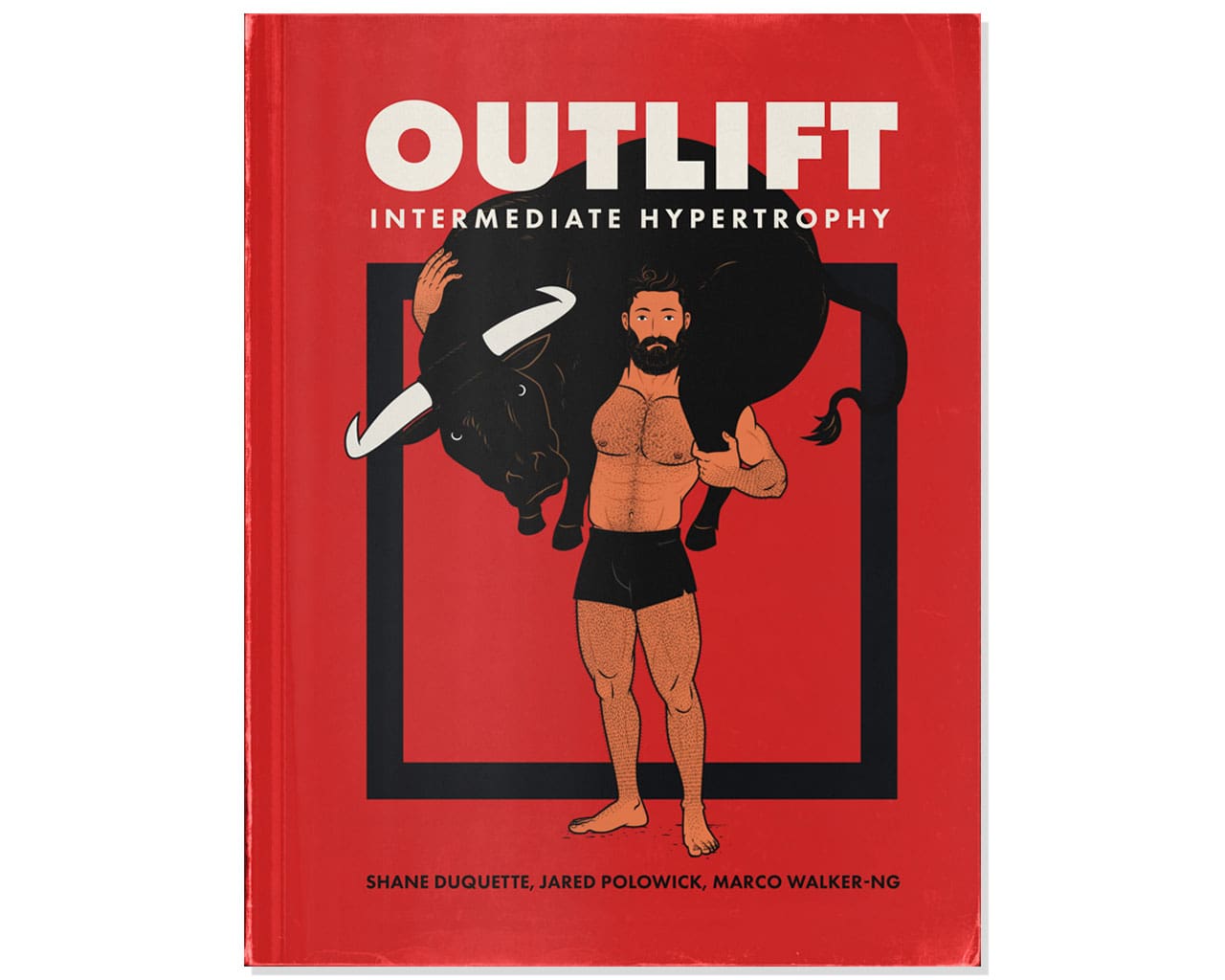
If you want a fully optimized 5-day workout split, check out our Outlift Intermediate Hypertrophy Program. It’s a 15-week customizable workout routine with guided progressive overload. It also comes with a full hypertrophy training guide. I think you’d really like it.
It isn’t quite the same routine as the one we outlined in this article. It has the same structure, but we’ve gotten more creative with the programming. The first phase is loosely inspired by classic bodybuilding, the second by modern natural bodybuilding, and the third uses undulating periodization, as many powerbuilding programs do.



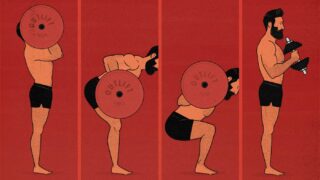
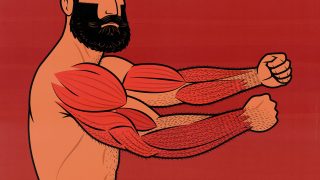

Hi Shane, great addition to the Bro split article. Short remark to the deadlift day: I assume the rep range for the high bar squats and cruches needs to be switched?
Oh, shoot! You’re right! Thank you, Sebastian. I’ll fix it right now.
Hey Shane, thanks for the article. Just wanted to check if there’s any specific reason for the different rest day break up for the Bro Split Vs Outlift Split? Or could the Outlift Split also be run as a 5 day in a row with 2 rest days?
My pleasure, Thomas!
You can do the Outlift Split 5 days in a row. I split it up to balance out the rest days, but you don’t have to. I think it’s handy if you’re trying to mix in cardio or if you don’t like taking two days off in a row. It’s a steadier rhythm. But it’s totally up to you. You’ll stimulate the same amount of muscle growth and get the same results either way.
Your workout program seems great, no doubt about that. I was thinking about the lower body days- shouldn’t the squat day be before the hip hinge day. I mean the deadlift and the other hip hinging exercises are quite taxing to the CNS and this could affect our next training sessions. Also the hams are recovering slower than the quads. When I do squats before the deadlifts, my second exercise is not so bad, but doing them in the opposite row, makes the second exercise more challenging.
Yeah, sure, you could do it like that. These workouts aren’t insanely strenuous. I don’t think you’d be accumulating too much fatigue. But if you notice fatigue, and if you notice that the different order suits you better, then that definitely makes sense.
Hamstrings aren’t all that involved in squats, so I don’t think they would play into it.
Yep, the squats are quad exercise, while the deadlifts hit the hams. It might be just me. From other hand the upper body order doesn’t bother me much.